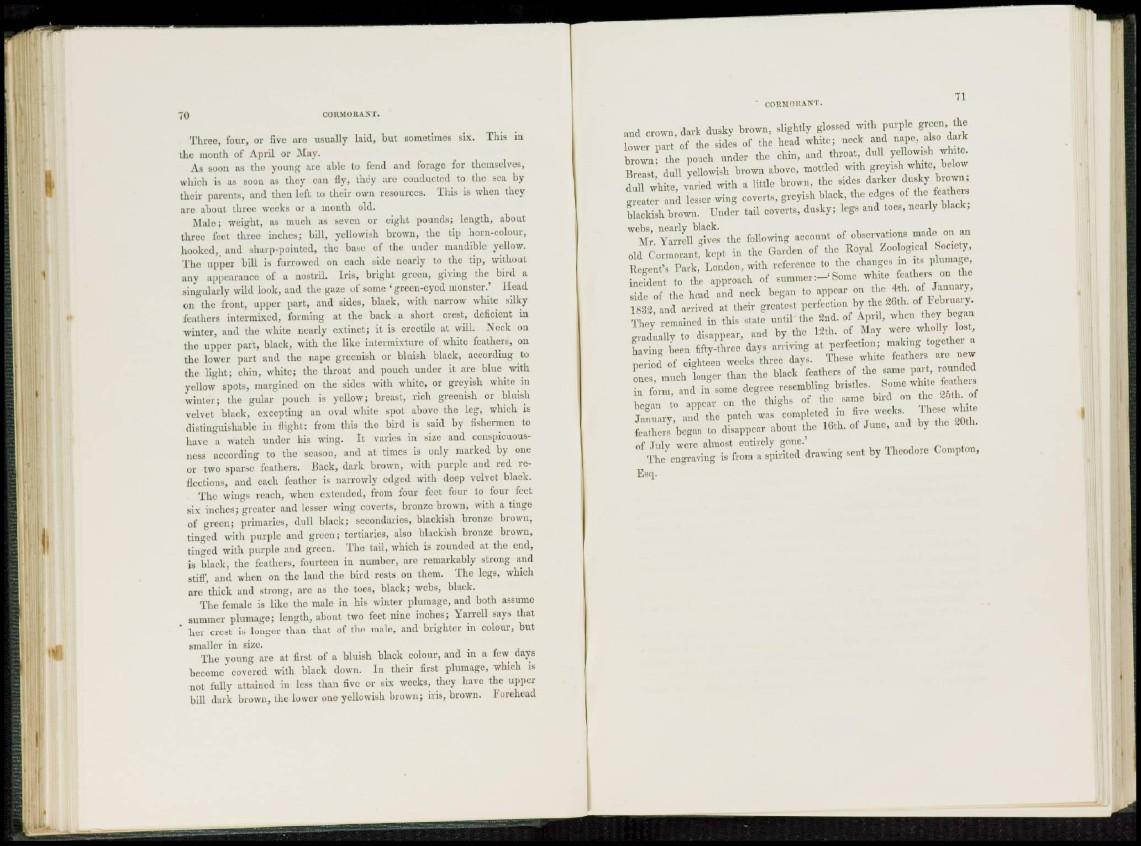
Three, four, or five are usually laid, but sometimes six. This ia
the month of April or May.
As soon as the young are able to fend and forage for themselves,
which is as soon as they can fly, they arc conducted to the sea by
their parents, and then left to their own resources. This is when they
are about three weeks or a month old.
Male; weight, as much as seven or eight pounds; length, about
three feet three inches; bill, yellowish brown, the tip horn-colour,
hooked, and sharp-pointed, the base of the under mandible yellow.
The upper bill is furrowed on each side nearly to the tip, without
any appearance of a nostril. Iris, bright green, giving the bird a
singularly wild look, and the gaze of some ' green-eyed monster.' Head
on the front, upper part, and sides, black, with narrow white silky
feathers intermixed, forming at the back a short crest, deficient in
winter, and the white nearly extinct; it is erectile at will. Neck on
the upper part, black, with the like intermixture of white feathers, on
the lower part and the nape greenish or bluish black, according to
the light; chin, white; the throat and pouch under it are blue with
yellow spots, margined on the sides with white, or greyish white in
winter; the gular pouch is yellow; breast, rich greenish or bluish
velvet black, excepting an oval white spot above the leg, which is
distinguishable in flight: from this the bird is said by fishermen to
have a watch under his wing. It varies in size and conspicuousness
according to the season, and at times is only marked by one
or two sparse feathers. Hack, dark brown, with purple and red reflections,
and each feather is narrowly edged with deep velvet black.
The wings reach, when extended, from four feet four to four feet
six inches; greater and lesser wing coverts, bronze brown, with a tinge
of green; primaries, dull black; secondaries, blackish bronze brown,
tinged with purple and green; tertiaries, also blackish bronze brown,
tinged with purple and green. The tail, which is rounded at the end,
is black, the feathers, fourteen in number, are remarkably strong and
stiff, and when on the land the bird rests on them. The legs, which
are thick and strong, are as the toes, black; webs, black.
The female is like the male in his winter plumage, and both assume
summer plumage; length, about two feet nine inches; Yarrell says that
her crest is longer than that of the male, and brighter in colour, but
smaller in size.
The young are at first of a bluish black colour, and in a few days
become covered with black down. In their first plumage, which is
not fully attained in less than five or six weeks, they have the upper
bill dark brown, the lower one yellowish brown; iris, brown. Forehead
and crown, dark dusky brown, slightly glossed with purple green, the
lower part of the sides of the head white; neck and nape, also dark
brown; the pouch under the chin, and throat, dull yellowish white.
Breast, dull yellowish brown above, mottled with greyish white, below
dull white, varied with a little brown, the sides darker dusky brown;
greater and lesser wing coverts, greyish black, the edges of the feathers
blackish brown. Under tail coverts, dusky; legs and toes, nearly black;
webs, nearly black.
Mr. Yarrell gives the following account of observations made on an
old Cormorant, kept in the Garden of the Royal Zoological Society,
Regent's Park, London, with reference to the changes in its plumage,
incident to the approach of summer:—'Some white feathers on the
side of the head and neck began to appear on the 4th. of January,
1832, and arrived at their greatest perfection by the 20th. of February.
They remained in this state until the '2nd. of April, when they began
gradually to disappear, and by the 12th. of May were wholly lost,
having been fifty-three days arriving at perfection; making together a
period of eighteen weeks three days. These white feathers are new
ones, much longer than the black feathers of the same part, rounded
in form, and in some degree resembling bristles. Some white feathers
began to appear on the thighs of the same bird on the 05th. of
Januarv, and the patch was completed in five weeks. These white
feathers began to disappear about the 10th. of J u n e , and by the 20th.
of J u l y were almost entirely gone.'
The engraving is from a spirited drawing sent by Theodore Compton,
E8 q .